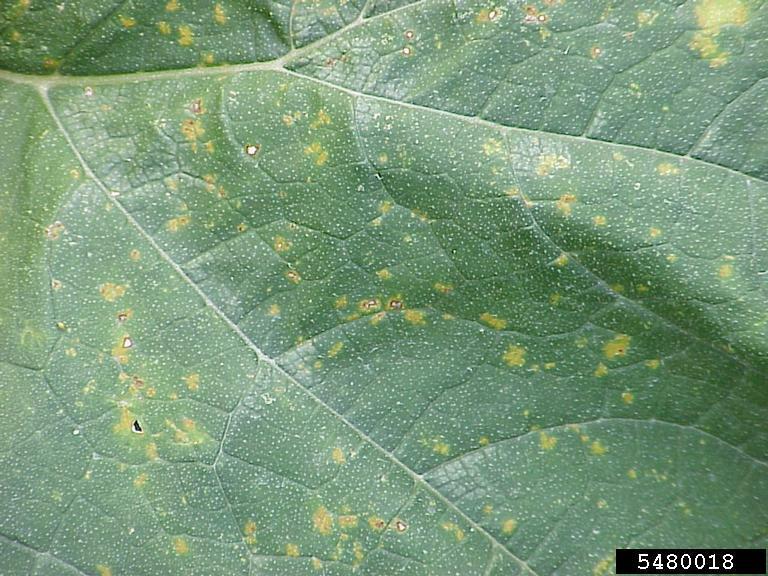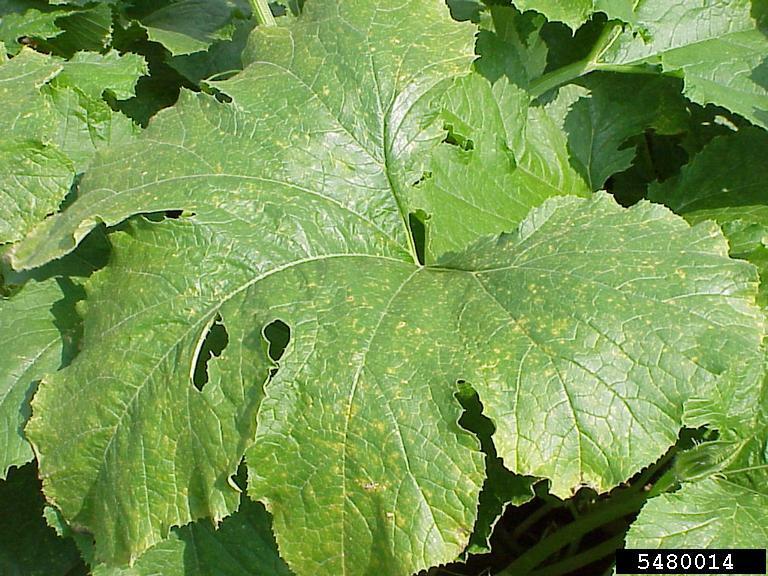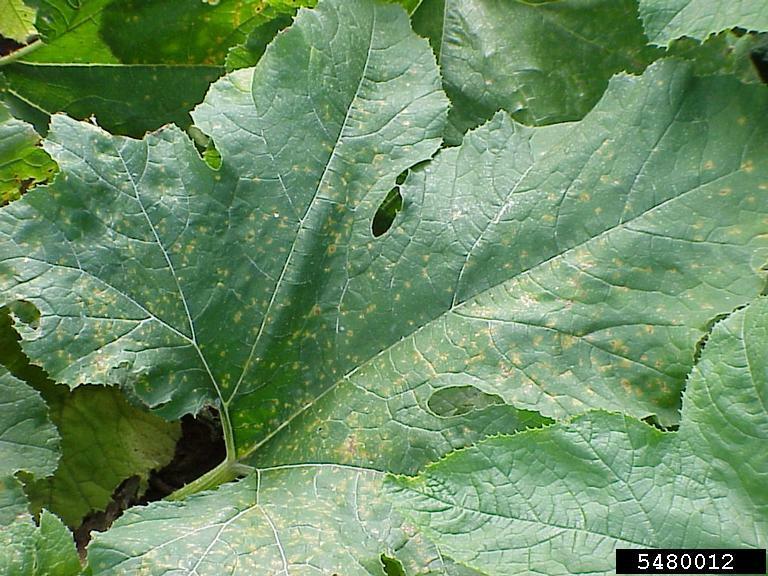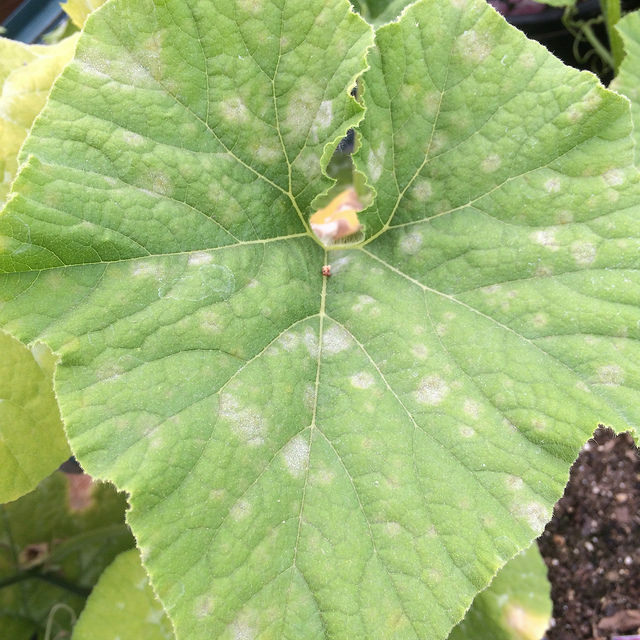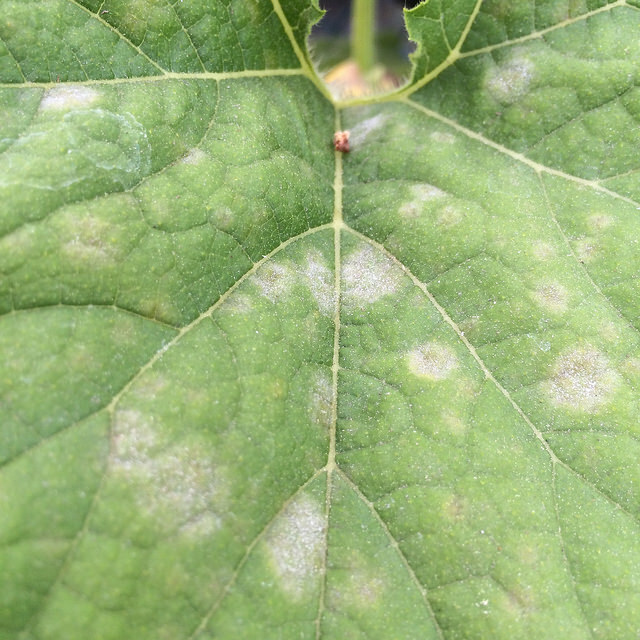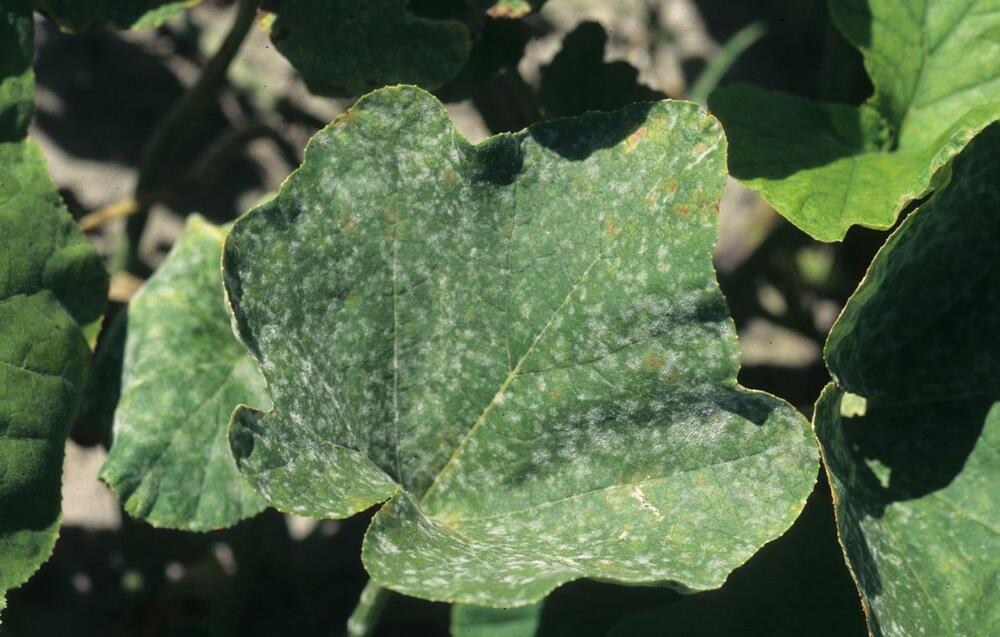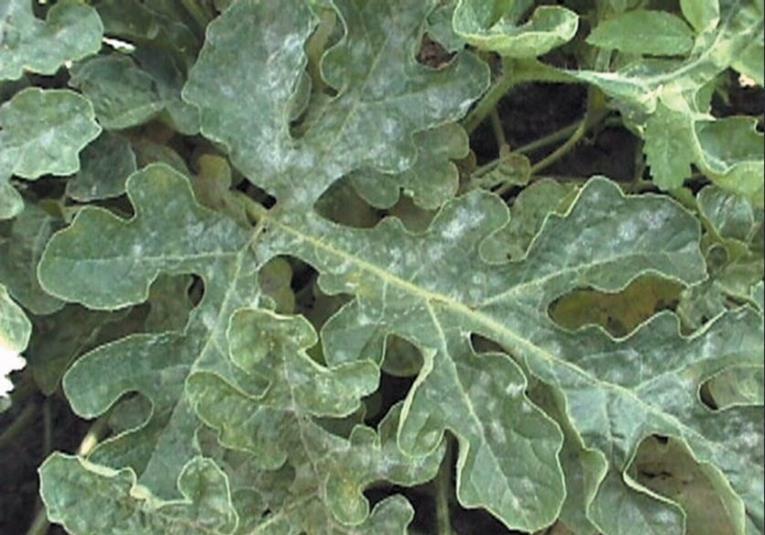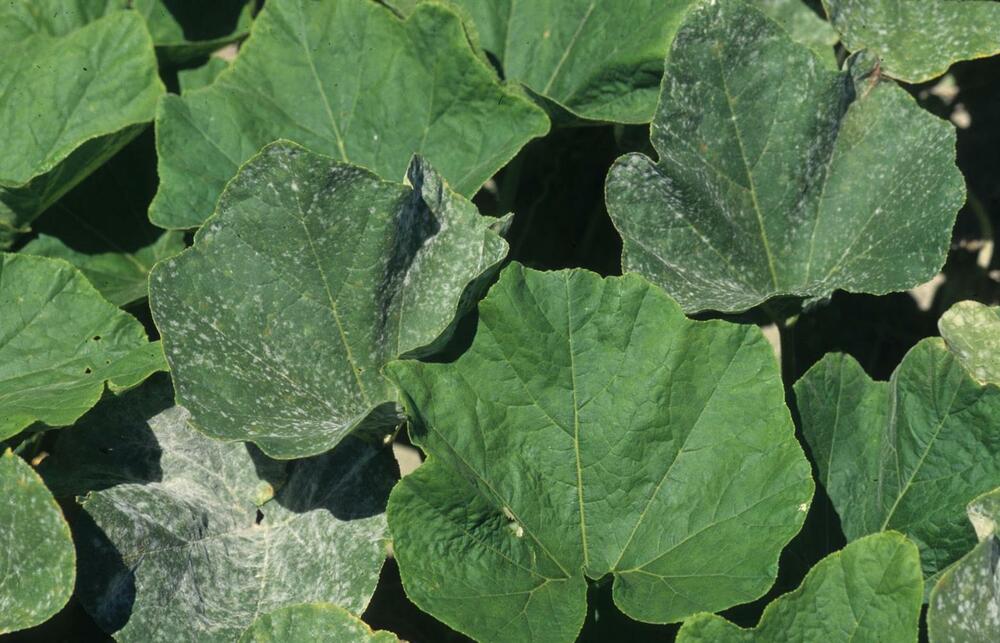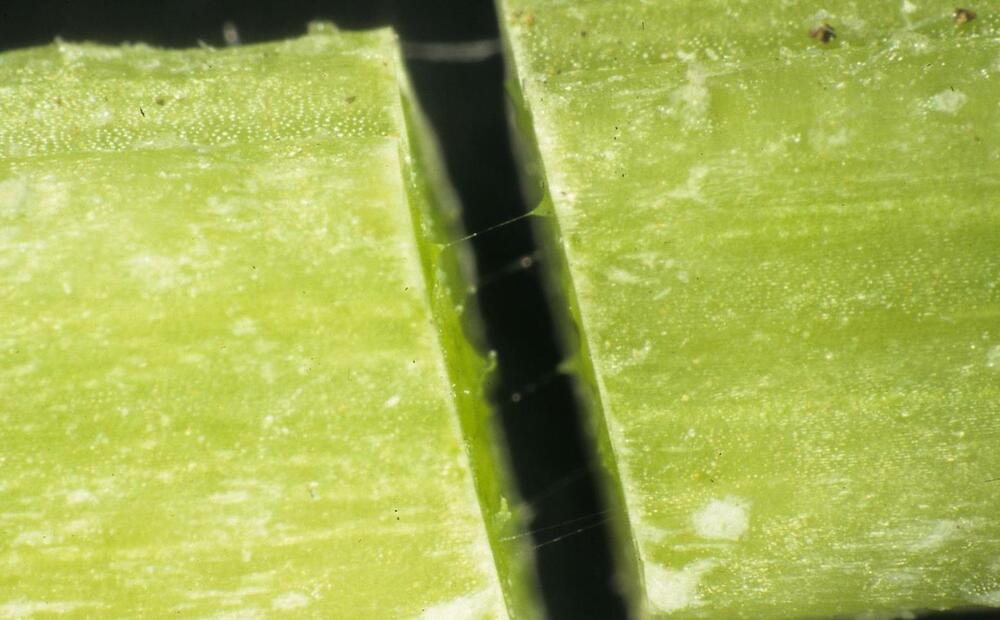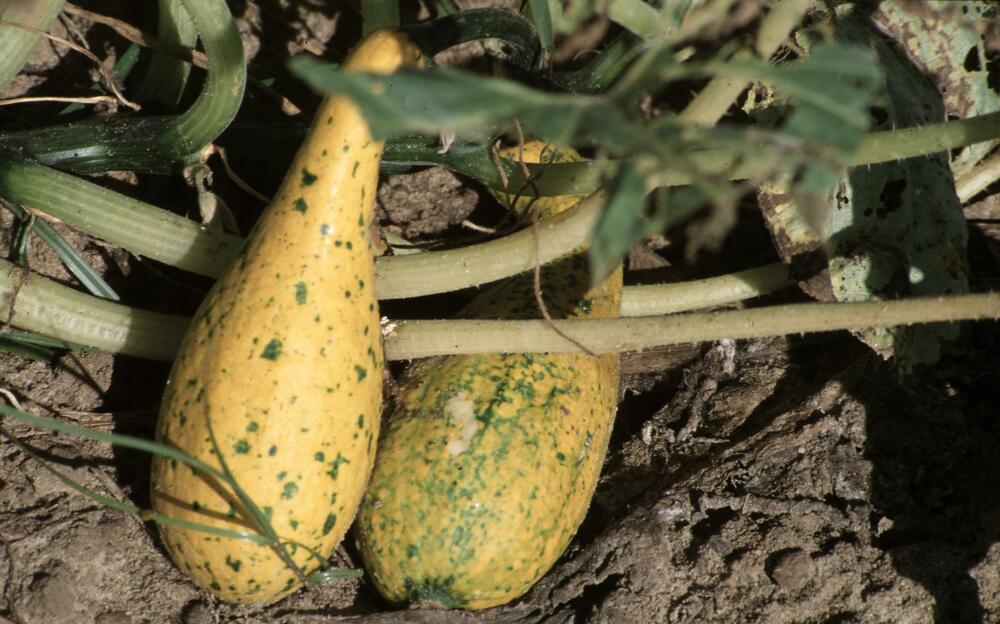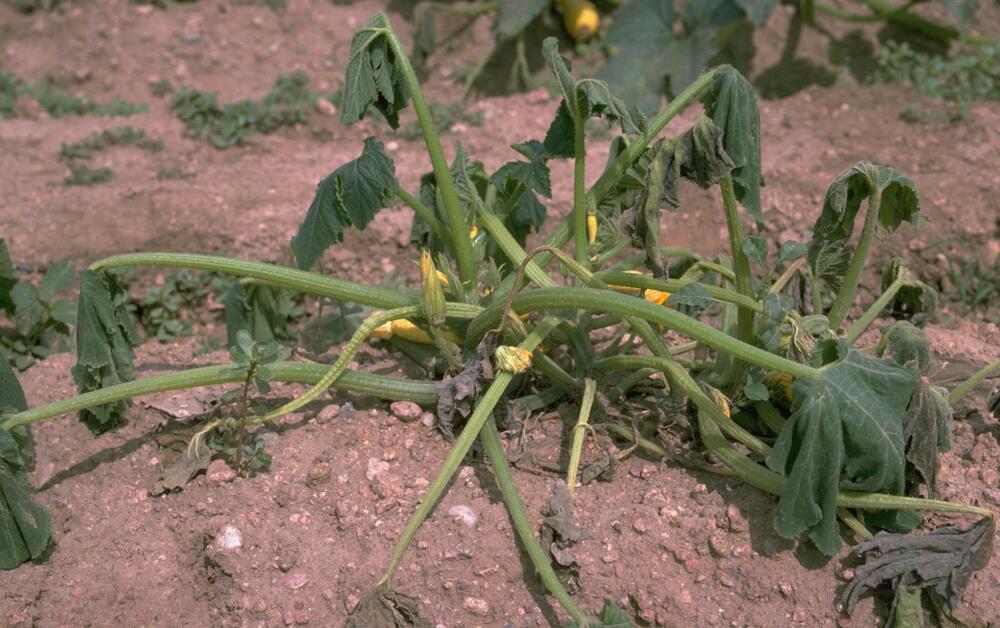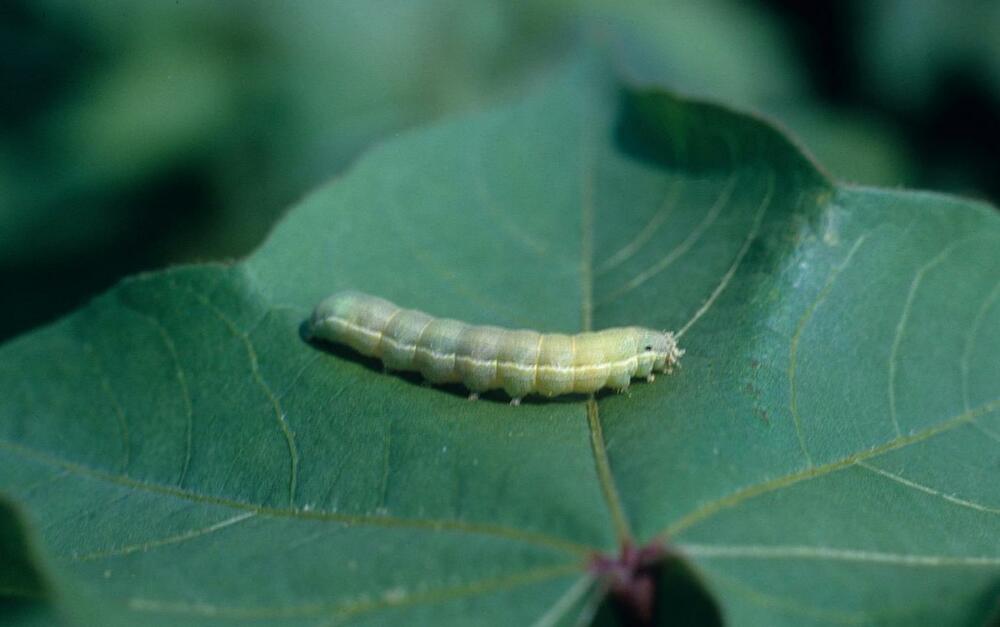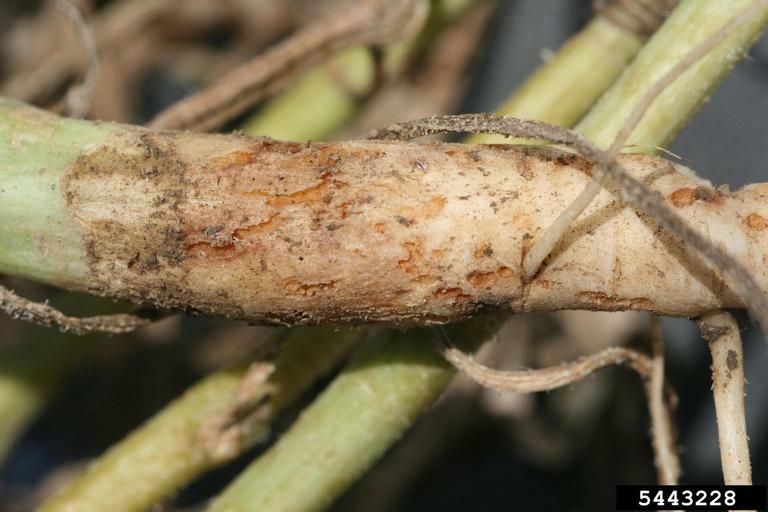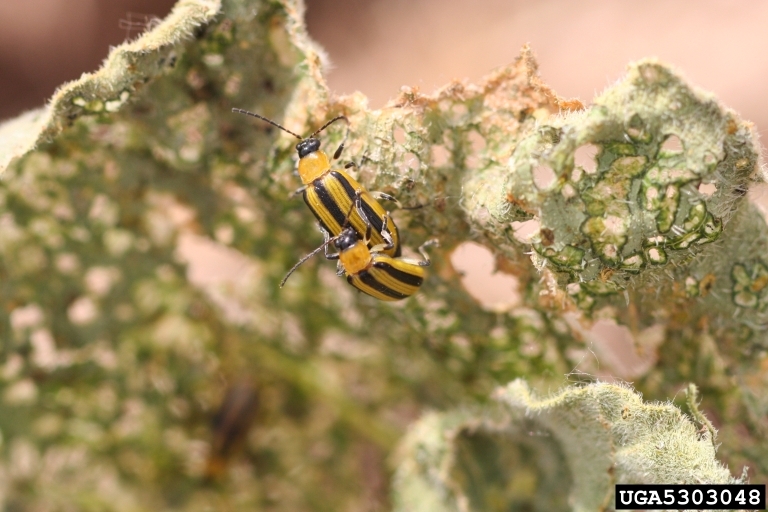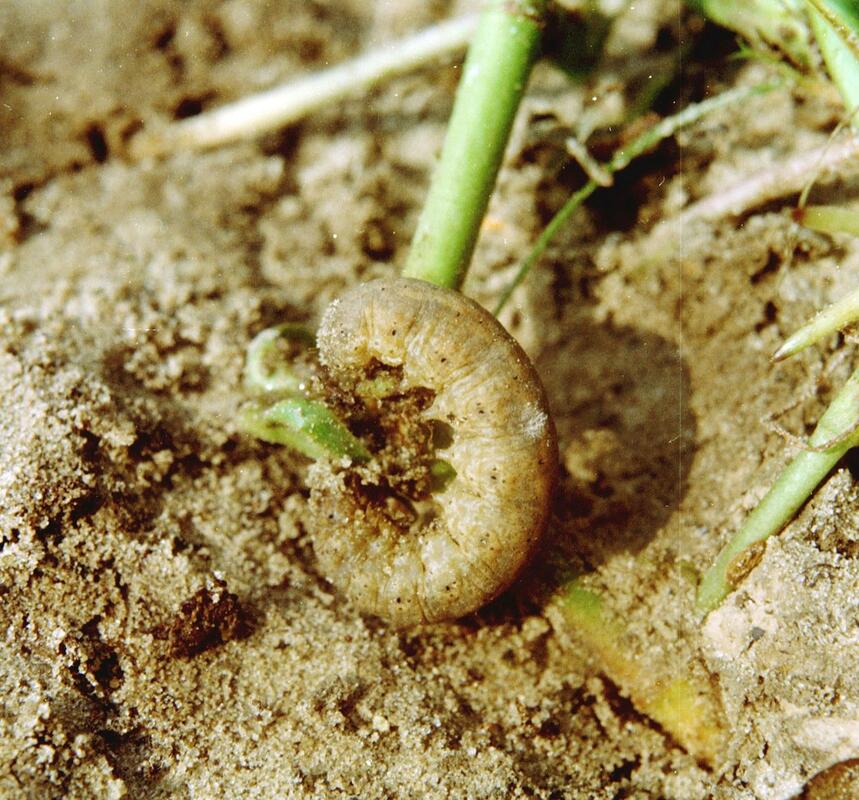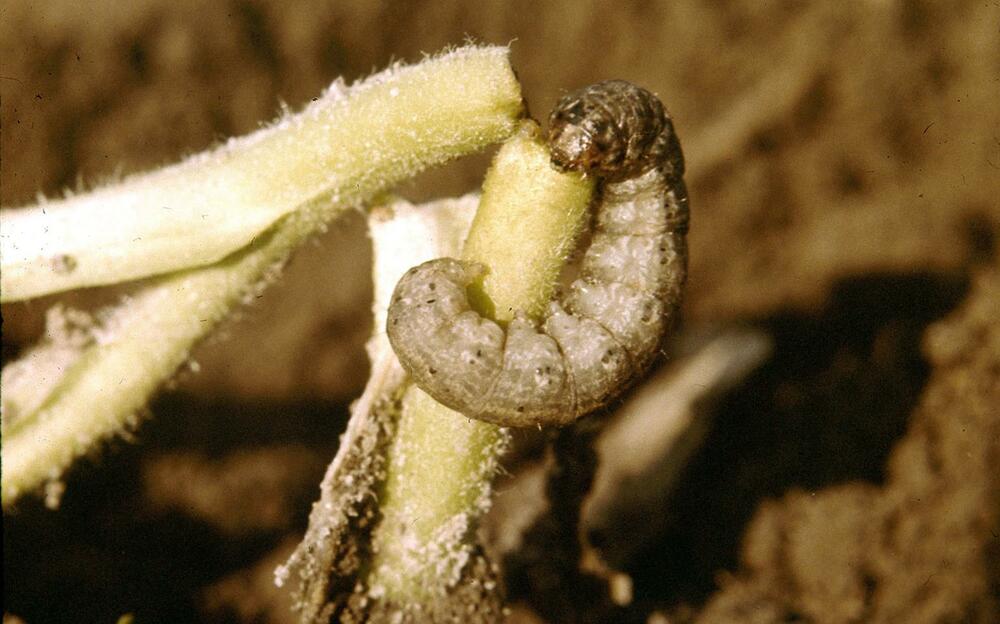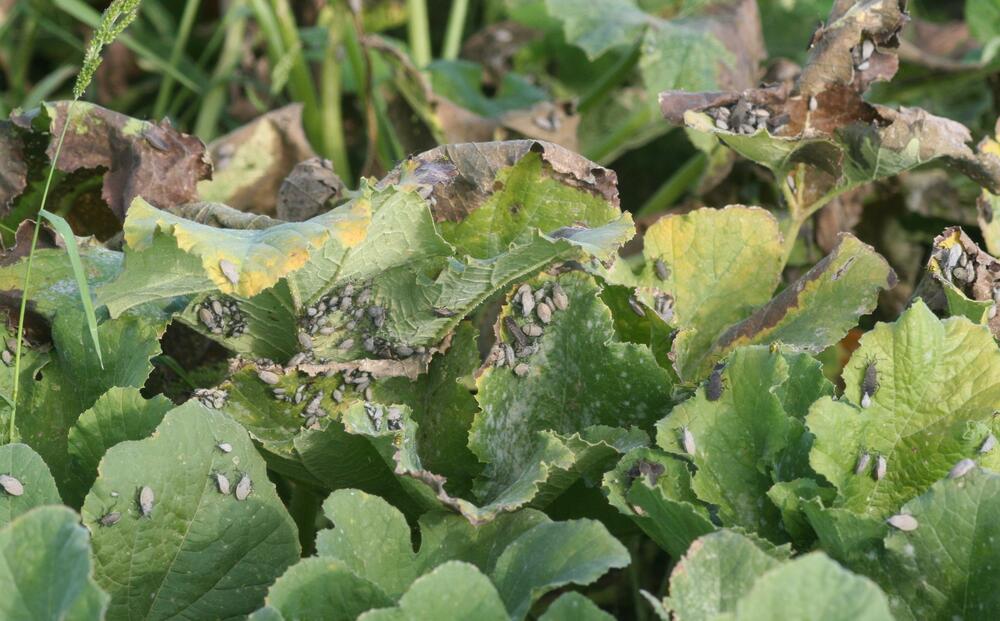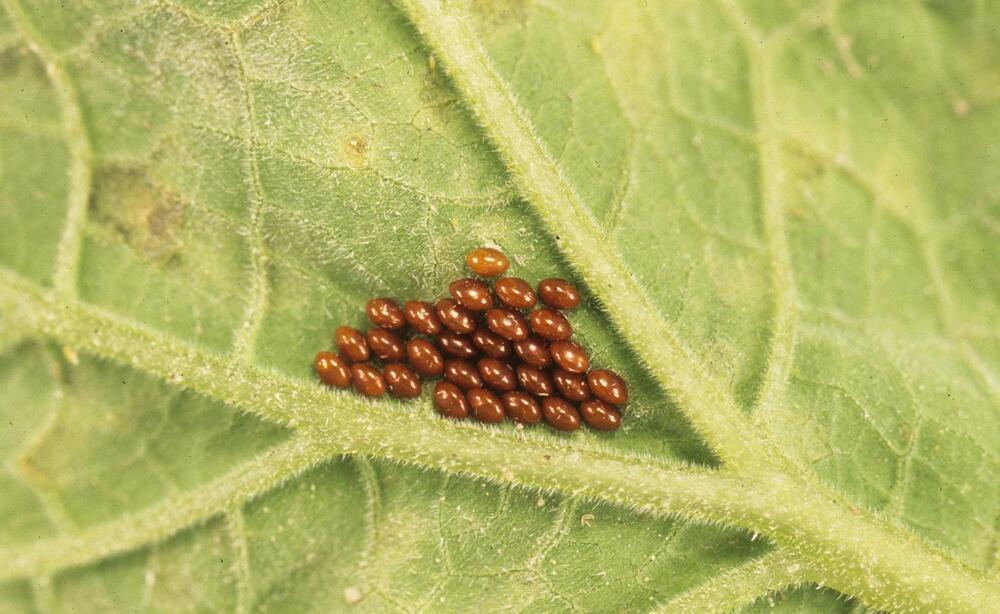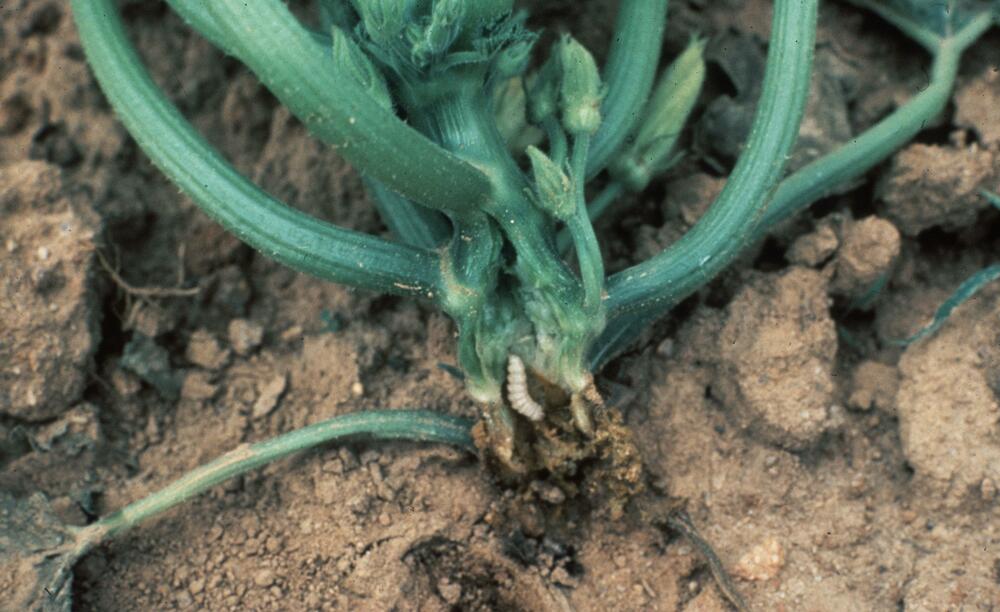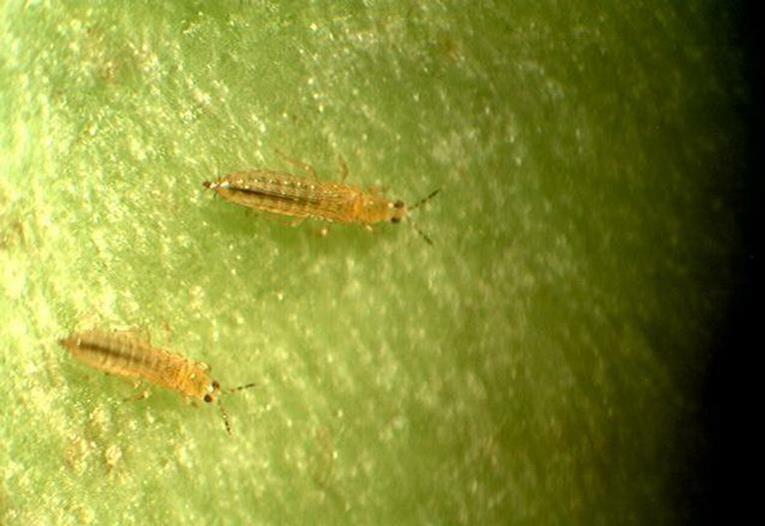Squash
Description
Uses
Propagation
References
Common Pests and Diseases
Diseases
Category : Fungal
Alternaria leaf blight Alternaria cucumerina
Symptoms
Small, yellow-brown spots with a yellow or green halo which first appear on the oldest leaves; as the disease progresses, lesions expand and become large necrotic patches, often with concentric patternation; lesions coalesce, leaves begin to curl and eventually die.
Cause
Fungus
Comments
Disease is prevalent in growing areas where temperatures are high and rainfall is frequent.
Management
Cucurbits should be rotated with another crop every 2 years to reduce levels of inoculum; crop debris should be removed from the field as quickly as possible after harvest or plowed deeply into the soil; applications of appropriate protective fungicides can help to slow the development of the disease; water plants from the base rather than from above to reduce periods of leaf wetness which are conducive to the development and spread of disease.Alternaria leaf spot (Brown spot) Alternaria alternata
Symptoms
Initial symptoms appear as necrotic flecks on leaves with chlorotic halos; as the disease progresses, the flecks grow into spots which may join together into large, roughly circular lesions; if infestation is severe, leaves begin to turn yellow and die.
Cause
Fungus
Comments
Pathogen survives between growing season on crop debris.
Management
Crops debris should be removed from the field or plowed deeply into the soil after harvest; applications of appropriate protective fungicides can hep reduce the incidence of the disease.Cercospora leaf spot Cercospora citrullina
Symptoms
Initial symptoms of disease occur on older leaves as small spots with light to tan brown centers; as the disease progresses, the lesions enlarge to cover large areas of the leaf surface; lesions may have a dark border and be surrounded by a chlorotic area; the centers of the lesions may become brittle and crack
Cause
Fungus
Comments
Fungus survives on plant debris; spread by wind and water splash; occurs mainly in tropical and subtropical growing regions
Management
Any diseased plants should be removed and destroyed to prevent further spread; crop debris should be removed after harvest or plowed deeply into the soil to reduce inoculumDowny mildew Pseudoperonospora cubensis
Symptoms
Small yellow areas on the upper leaf surface; brown lesions with irregular margins; gray mold on lower leaf surface.
Cause
Fungus
Comments
Disease emergence favored by moist conditions.
Management
Do not overcrowd plants; avoid overhead irrigation, water plants from base; apply appropriate fungicide.Fusarium crown and foot rot Fusarium solani
Symptoms
Wilting of leaves progresses to wilting of entire plant and plant dies within a few days; distinctive necrotic rot of crown and upper taproot when plant is uprooted; plant breaks easily below soil line
Cause
Fungus
Comments
Fungus can survive in soil for 2-3 years
Management
Plant fungicide treated seed; rotate crops on 4 year rotationGummy stem blight Didymella bryoniae
Symptoms
Brown or tan spots of various sizes on leaves; leaves covered with lesions; stems splitting and forming cankers; wounds exude a brown, gummy substance; wilting vines; death of stems
Cause
Fungus
Comments
Disease may be seed-borne
Management
Use disease free seed; treat seeds prior to planting; rotate crops every 2 years
Powdery mildew
Erysiphe cichoracearum
Sphaerotheca fuliginea
Podosphaera xanthii
Symptoms
White powdery growth on the upper surfaces of leaves and stems; infected areas stunted and distorted.
Cause
Fungi
Comments
Disease emergence favored by dry weather and high relative humidity.
Management
Plant in sites with good air circulation and sun exposure; do not overcrowd plants; sanitize equipment regularly.Septoria leaf spot Septoria cucurbitacearum
Symptoms
Initial symptoms of disease are small dark water-soaked spots on the leaves which turn beige to white in dry conditions; lesions develop thin brown borders and the centers may become brittle and crack; small white spots may erupt on the surface of infected butternut and acorn squash and pumpkin fruit
Cause
Fungus
Comments
Pathogen can survive on crop debris for periods in excess of 1 year
Management
Scout plants during cool wet conditions for any sign of spots; early application of an appropriate protective fungicide can help limit the development of the disease if spots are found, cucurbits should be rotated with other crops every 2 years to prevent the build-up of inoculum; crop debris should be removed and destroyed after harvestVerticillium wilt Verticillium dahliae
Symptoms
Symptoms generally appear after fruit set; chlorotic leaves which develop necrotic areas; leaves collapsing; symptoms only on one side of vine; discoloration of vascular tissue in roots
Cause
Fungus
Comments
Fungus can survive in soil for many years; disease emergence favored by cool or mild weather in Spring
Management
Do not plant in areas where other susceptible crops have been grown previously; delay planting until temperatures are warmerCategory : Bacterial
Angular leaf spot Pseudomonas syringae
Symptoms
Small water-soaked lesions on leaves which expand between leaf veins and become angular in shape; in humid conditions, lesions exude a milky substance which dries to form a white crust on or beside lesions; as the disease progresses, lesions turn tan and may have yellow/green edges; the centers of the lesions dry and may drop out leaving a hole in the leaf
Cause
Bacterium
Comments
Spread through infected seed, splashing rain, insects and movement of people between plants; bacterium overwinters in crop debris and can survive for 2.5 years
Management
Use disease-free seed; do not grow plants in field where cucurbits have been grown in the previous 2 years; protective copper spray may help reduce incidence of disease in warm, humid climates; plant resistant varietiesBacterial leaf spot Xanthomonas campestris
Symptoms
Dark, angular lesions on leaves; leaf lesions may coalesce and cause severely blighted foliage; water-soaked lesions which enlarge and develop into tan scabs, or blisters, on the fruit; blisters eventually flatten as they reach their full size
Cause
Bacterium
Comments
Disease can spread rapidly in a field; disease can be introduced through contaminated seed
Management
Avoid overhead irrigation; rotate crops away from cucurbit species to prevent disease building up; use new seed each planting as saved seed is more likely to carry bacteria; apply appropriate protective fungicides; copper containing fungicides generally provide good controlBacterial wilt Erwinia tracheiphila
Symptoms
Severely wilted vines; leaves appear dark green; dark discoloration on leaves and stems; rapid plant death
Cause
Bacterium
Comments
Spread by striped or spotted cucumber beetles; disease can be confirmed by cutting the stem and slowly pulling the two ends apart - infected plants will ooze strings of bacterial exudate
Management
Control cucumber beetle populations on plants; hand pick adult beetles and destroy; soil and foliar application of appropriate insecticides may help to control populationsCategory : Other
Aster yellows Aster yellows phytoplasma
Symptoms
Foliage turning yellow; secondary shoots begin growing prolifically; stems take on a rigid, upright growth habit; leaves are often small in size and distorted, may appear thickened; flowers are often disfigured and possess conspicuous leafy bracts; fruits are small and pale in color
Cause
Phytoplasma
Comments
Disease is transmitted by leafhoppers and can cause huge losses in cucurbit crops
Management
Remove any infected plants from the field to reduce spread; control weeds in and around the field that may act as a reservoir for the phytoplasma; protect plants from leaf hopper vectors with row coversBlossom-end rot
Symptoms
Symptoms first appear on immature fruits as small light brown spots close to the blossom end of the fruit; as fruit grow, the spots enlarge, resulting in dark leathery lesions sunken into the fruit
Cause
Nutritional disorder
Comments
Management
Blossom-end rot is caused by a lack of calcium in the developing fruit and it occurs when the uptake of nutrients to the plant is disrupted; factors which disrupt nutrient uptake include drought, root damage or high soil salinity; application of excess nitrogen fertilizer may also contribute to the development of blossom-end rot as it promotes vigorous growth of vegetative tissues and depletion of calcium in the soil; watering plants evenly and regularly reduces the incidence of blossom-end rotCategory : Viral
Cucumber mosaic Cucumber mosaic virus (CMV)
Symptoms
Plants are severely stunted; foliage is covered in distinctive yellow mosaic; leaves of plant curl downwards and leaf size is smaller than normal; flowers on infected plants may be deformed with green petals; fruits become distorted and are small in size; fruit is often discolored.
Cause
Virus
Comments
Transmitted by aphids; virus has an extensive host range; can be mechanically transmitted via tools etc.
Management
Control of the virus is largely dependant on the control of the aphid vectors; reflective mulches can deter aphid feeding; aphid outbreaks can be treated with mineral oils or insecticidal soap applications; some resistant varieties are available.
Cucurbit yellow stunting disorder virus
Cucurbit yellow stunting disorder virus (CYSDV)
Genus: Crinivirus
Group: "Positive sense ssRNA viruses"
Symptoms
The symptoms generally appear on the older leaves first. Initially the symptom appears as chlorotic spotting which leads to intervenial chlorosis and followed by severe yellowing. The infected leaves may roll upward and become brittle. Also the infected plant may appear stunted.
Cause
Virus
Comments
The virus is mainly transmitted by whitefly Bemisia tabaci. The host range is restricted to the Cucurbitaceae (watermelon, melon, cucumber, squash, courgette etc.,).
Management
Grow virus free and whiteflies free seed materials. During the growing season use yellow sticky traps to monitor and control whiteflies. Remove the infected plants and burn them. Keep the field free from weeds. In case severe infestation of whiteflies, use suitable insecticides. After a growing season remove the crop debris, volunteer plants and destroy them.Squash mosaic Squash mosaic virus (SqMV)
Symptoms
Symptoms vary with variety being grown but plants can show symptoms which include include green veinbanding, mottled leaves, blisters, ring spots or potruding veins at leaf margins; some squash varieties may develop leaf enations; infected plants are often stunted and fruits may be malformed with mottled skin
Cause
Virus
Comments
Virus can be transmitted through infected seed and spread by striped cucumber beetles
Management
Use only certified disease-free seedWatermelon mosaic Watermelon mosaic virus (WMV)
Symptoms
Symptoms vary widely depending on species, cultivar, virus strain and environmental conditions; symptoms on leaves may include green mosaic patternation, green vein-banding, chlorotic rings and disfigured leaves; infected fruits may develop green spots - particularly if fruit is yellow
Cause
Virus
Comments
Virus is found in almost all Cucurbit growing regions in the world; virus is spread by over 20 aphid species
Management
Use of resistant varieties can greatly reduce virus incidence; treatments that control populations of aphid vectors can also reduce the incidence of the virus; spraying plants with mineral oils or insecticidal soaps can help to reduce aphid numbersZucchini yellow mosaic Zucchini yellow mosaic virus (ZYMV)
Symptoms
Infected plants are severely stunted and leaves can exhibit a variety of symptoms including yellow mosaic patternation, severe deformation, blistering, reduced size and necrosis; fruits are deformed
Cause
Virus
Comments
DIsease can cause devastating epidemics when present
Management
Use of resistant varieties, where available, is usually the most effective method of controlling the virus; control of aphid populations on the plants can be achieved through the use of mineral oils and insecticidal soaps but is rarely effective at controlling the virusCategory : Oomycete
Phytophthora crown and root rot Phytophthora capsici
Symptoms
Sudden and permanent wilting of plant; leaves do not change color; plant death within a few days; roots and stem close to soil line discolored light to dark brown; plant easily removed from soil
Cause
Oomycete
Comments
Fungus can be spread through air; disease emergence favors high temperatures and water saturated soil
Management
Efficient management of water to avoid saturated soil; avoid long periods of irrigationPests
Category : Insects
Aphids (Peach aphid, Melon aphid)
Myzus persicae
Aphis gossypii
Symptoms
Small soft bodied insects on underside of leaves and/or stems of plant; usually green or yellow in color, but may be pink, brown, red or black depending on species and host plant; if aphid infestation is heavy it may cause leaves to yellow and/or distorted, necrotic spots on leaves and/or stunted shoots; aphids secrete a sticky, sugary substance called honeydew which encourages the growth of sooty mold on the plants
Cause
Insects
Comments
Distinguishing features include the presence of cornicles (tubular structures) which project backwards from the body of the aphid; will generally not move very quickly when disturbed
Management
If aphid population is limited to just a few leaves or shoots then the infestation can be pruned out to provide control; check transplants for aphids before planting; use tolerant varieties if available; reflective mulches such as silver colored plastic can deter aphids from feeding on plants; sturdy plants can be sprayed with a strong jet of water to knock aphids from leaves; insecticides are generally only required to treat aphids if the infestation is very high - plants generally tolerate low and medium level infestation; insecticidal soaps or oils such as neem or canola oil are usually the best method of control; always check the labels of the products for specific usage guidelines prior to use
Armyworms (Beet armyworm, Western striped armyworm)
Spodoptera exigua
Spodoptera praefica
Symptoms
Singular, or closely grouped circular to irregularly shaped holes in foliage; heavy feeding by young larvae leads to skeletonized leaves; shallow, dry wounds on fruit; egg clusters of 50-150 eggs may be present on the leaves; egg clusters are covered in a whitish scale which gives the cluster a cottony or fuzzy appearance; young larvae are pale green to yellow in color while older larvae are generally darker green with a dark and light line running along the side of their body and a pink or yellow underside
Cause
Insect
Comments
Insect can go through 3–5 generations a year
Management
Organic methods of controlling armyworms include biological control by natural enemies which parasitize the larvae and the application of Bacillus thuringiensis; there are chemicals available for commercial control but many that are available for the home garden do not provide adequate control of the larvaeCabbage looper Trichoplusia ni
Symptoms
Large or small holes in leaves; damage often extensive; caterpillars are pale green with a white lines running down either side of their body; caterpillars are easily distinguished by the way they arch their body when moving; eggs are laid singly, usually on the lower leaf surface close to the leaf margin, and are white or pale green in color
Cause
Insect
Comments
Insects overwinter as pupae in crop debris in soil; adult insect id a dark colored moth; caterpillars have a wide host range
Management
Looper populations are usually held in check by natural enemies; if they do become problematic larvae can be hand-picked from the plants; an organically acceptable control method is the application of Bacillus thuringiensis which effectively kills younger larvae; chemical sprays may damage populations of natural enemies and should and should be selected carefully
Cucumber beetles (Western striped cucumber beetle, Western spotted cucumber beetle, Banded cucumber beetle)
Acalymma vittata
Diabrotica undecimpunctata
Diabrotica balteata
Symptoms
Stunted seedling; damaged leaves, stems and/or petioles; reduced plant stand; plants may exhibit symptoms of bacterial wilt; scars on fruit caused by beetle feeding damage; adult beetles are brightly colored with either a green-yellow background and black spots or alternating black and yellow stripes.
Cause
Insect
Comments
Beetles overwinter in soil and leaf litter and emerge from soil when temperatures begin to reach and exceed 12.7°C (55°F).
Management
Monitor new planting regularly for signs of beetle; floating row covers can be used to protect the plants from damage but will need to be removed at bloom to allow bees to pollinate plants; applications of kaolin clay can be effective for management of small beetle populations; application of appropriate insecticides may be necessary.
Cutworms
Agrotis spp.
Peridroma saucia
Nephelodes minians
and others
Symptoms
Stems of young transplants or seedlings may be severed at soil line; if infection occurs later, irregular holes are eaten into the surface of fruits; larvae causing the damage are usually active at night and hide during the day in the soil at the base of the plants or in plant debris of toppled plant; larvae are 2.5–5.0 cm (1–2 in) in length; larvae may exhibit a variety of patterns and coloration but will usually curl up into a C-shape when disturbed.
Cause
Insects
Comments
Cutworms have a wide host range and attack vegetables including asparagus, bean, cabbage and other crucifers, carrot, celery, corn, lettuce, pea, pepper, potato and tomato.
Management
Remove all plant residue from soil after harvest or at least two weeks before planting, this is especially important if the previous crop was another host such as alfalfa, beans or a leguminous cover crop; plastic or foil collars fitted around plant stems to cover the bottom 3 inches above the soil line and extending a couple of inches into the soil can prevent larvae severing plants; hand-pick larvae after dark; spread diatomaceous earth around the base of the plants (this creates a sharp barrier that will cut the insects if they try and crawl over it); apply appropriate insecticides to infested areas of garden or field if not growing organically.Flea beetles Epitrix spp.
Symptoms
Small holes or pits in leaves that give the foliage a characteristic “shothole” appearance; young plants and seedlings are particularly susceptible; plant growth may be reduced; if damage is severe the plant may be killed; the pest responsible for the damage is a small (1.5–3.0 mm) dark colored beetle which jumps when disturbed; the beetles are often shiny in appearance.
Cause
Insects
Comments
Younger plants are more susceptible to flea beetle damage than older ones; older plants can tolerate infestation; flea beetles may overwinter on nearby weed species, in plant debris or in the soil; insects may go through a second or third generation in one year.
Management
In areas where flea beetles are a problem, floating row covers may have to be used prior to the emergence of the beetles to provide a physical barrier to protect young plants; plant seeds early to allow establishment before the beetles become a problem - mature plants are less susceptible to damage; trap crops may provide a measure of control - cruciferous plants are best; application of a thick layer of mulch may help prevent beetles reaching surface; application on diamotecoeus earth or oils such as neem oil are effective control methods for organic growers; application of insecticides containing carbaryl, spinosad, bifenthrin and permethrin can provide adequate control of beetles for up to a week but will need reapplied.Leaf miners Lyriomyza spp.
Symptoms
Thin, white, winding trails on leaves; heavy mining can result in white blotches on leaves and leaves dropping from the plant prematurely; early infestation can cause fruit yield to be reduced; adult leafminer is a small black and yellow fly which lays its eggs in the leaf; larave hatch and feed on leaf interior
Cause
Insect
Comments
Mature larvae drop from leaves into soil to pupate; entire lifecycle can take as little as 2 weeks in warm weather; insect may go through 7 to 10 generations per year
Management
Check transplants for signs of leafminer damage prior to planting; remove plants from soil immediately after harvest; only use insecticides when leafminer damage has been identified as unnecessary spraying will also reduce populations of their natural enemiesSquash bug Anasa tristis
Symptoms
Speckled leaves which turn yellow and brown; wilting plants; dieback of runners; blemished fruit; fruit death; adult squash bugs are often misidentified as stink bugs; they are grey-black in color with orange and black stripes on the edges of their abdomen; nymphs are greenish gray in color and often covered in white powder; female squash bugs lay conspicuous copper colored eggs on the undersides of the leaves
Cause
Insect
Comments
Squash bugs overwinter in crop debris or under rocks and stones
Management
Destroy all crops residue as soon as possible after harvest or on plant death; apply row covers at planting; apply insecticidal soap or appropriate insecticideSquash vine borer Melittia cucurbitae
Symptoms
Wilting plants; holes in vines or at base of petioles; green frass (insect excrement) visible around holes
Cause
Insect
Comments
Insect overwinters in soil as larvae or pupae and adults emerge in spring; adults lay eggs on leaves and larvae burrow intro stems to feed
Management
Apply appropriate insecticide if eggs are found on leaves; plow plants into soil after harvestStinkbugs (Various) Various
Symptoms
Dark colored pinpricks on fruit surrounded by a lighter area that turns yellow or remains light green; stink bugs often carry pathogens in their mouthparts which can cause secondary infections and decay of fruit; adult insect is shield-shaped and brown or green in color; may have pink, red or yellow markings; eggs are drum shaped and laid in clusters on the leaves; larvae resemble the adults but are smaller
Cause
Insect
Comments
Adult insects overwinter under leaves, on legumes, blackberries or on certain weeds such as mustard or Russian thistle
Management
Remove weeds around crop which may act as overwintering sites for stink bugs and practice good weed management throughout the year; organically accepted control methods include the use of insecticidal soaps, kaolin clay and preservation of natural enemies; chemical treatments are not recommended for tomatoes that are to be processed for paste or canning unless secondary infections with other pathogens are a concernThrips (Western flower thrips, etc.) Frankliniella occidentalis
Symptoms
If population is high leaves may be distorted; leaves are covered in coarse stippling and may appear silvery; leaves speckled with black feces; insect is small (1.5 mm) and slender and best viewed using a hand lens; adult thrips are pale yellow to light brown and the nymphs are smaller and lighter in color
Cause
Insect
Comments
Transmit viruses such as Tomato spotted wilt virus; once acquired, the insect retains the ability to transmit the virus for the remainder of its life















